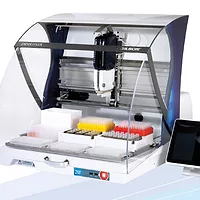Partnering Automation and Food Pathogen Testing

Accurate, reliable and thorough pathogen testing is a critical step in a manufacturer’s food safety program. As regulations and demand put greater pressure on pathogen testing, food laboratories must function more efficiently, consistently and at higher capacities. Automation is the most effective solution to meet these challenges.
Roka Automated Instrument
The recently launched Roka Automated Instrument is a fully automated pathogen detection instrument that provides the flexibility and efficiency to help laboratories meet mounting pressures without having to add resources. By combining a proven molecular technology with a complete “samples in, results out” system, the instrument eliminates the time-consuming upstream manual processing associated with traditional methods while providing a rapid result.
Improved Laboratory Efficiency
Improving laboratory efficiencies and removing processing bottlenecks is the quickest, most effective way to increase output without additional personnel. The instrument combines true walk-away capability with simplified three-step processing that allows laboratories to operate at optimized efficiency.
Easy Three-step Procedure
Utilizing a simple three-step enrich-transfer-automate procedure, samples are processed in a continuous flow through the instrument. Samples require only one enrichment step using a cost-effective, commercially available medium for each pathogen. Enriched samples are directly transferred to the prefilled Roka Transfer Tube and then placed on the automated instrument to complete processing. This method requires less than 30 seconds of direct hands-on time for every sample.
Continuous Access
One unique feature of this instrument is the ability to continuously add samples to the instrument for processing. Traditional methods require batch processing to optimize work flow that may not accommodate samples flowing into a laboratory in different volumes and at different times, and often lead to resource bottlenecks and slower time-to-result. The continuous access feature of the instrument removes the batching requirement by allowing samples to be processed as a flow, eliminating bottlenecks while providing greater efficiency without sacrificing time-to-result.
Rapid Throughput
A key feature of the instrument is its scalability in throughput. From enrichment through results, the instrument provides, with just a single operator and minimal hands-on time, the capacity to process more than 300 samples in a single 8-hour shift or more than 500 samples in a 12-hour shift. For midsize laboratories, the instrument can provide significant work-flow advantages with as few as 50 samples per day over current methods.
Internal Process Controls
Retesting samples due to operator error in processing can cost significant time and resources to any laboratory. The instrument has a series of internal process controls that ensures reliability and accuracy of results and eliminates steps prone to operator error.
Utilizing liquid level-sensing technology, the system can detect the dispensing and aspiration of each reagent and sample into the reaction tube, ensuring accuracy and reproducibility of each result. In addition, all reagent and system fluids on board are tracked and inventoried by the instrument. This ensures that an expired or mislabeled reagent is not mistakenly added to the process. Every reaction also includes an internal control that confirms that the purification, amplification and detection of the target were performed properly. Lastly, a comprehensive barcode system allows full traceability from enrichment to result, eliminating any chance of transcription errors or mislabeling of samples.
These systems allow a smooth and single processing for all samples. Testing is required only once, and a complete and accurate audit trail of each sample is available at the touch of a button.
Proven Technology
Automation partnered with powerful molecular technology provides a complete testing solution. Roka technology provides levels of specificity that ensure only the target pathogen is detected. The Roka Pathogen Detection Assays combine the advantages of rRNA amplification with an innovative target-capture step to further increase the detection of low-level bacterial species in even the most difficult food and environmental samples. This is a postlysis step that cross-links the specific target rRNA to the magnetic capture bead, allowing concentration and purification of only the target rRNA for amplification. Target capture is followed by transcription-mediated amplification, a robust, isothermal, amplification in only 30 minutes. Finally, a specific probe is added to the amplified target and presented for detection. This allows for a low background-wide signal-to-noise platform that minimizes false positives.
Today, the food safety testing laboratory is challenged by escalating demands measured against declining budgets and resource constraints. As testing volumes have increased, so too have the number of available platforms and diverse complexity of the associated tests. Amid this complexity, one molecular platform stands out: the Roka Automated Instrument. By combining automation with the full power of molecular technology, this instrument improves work flow while reducing time-to-result and enables laboratories to make more confident, informed decisions.
rokabio.com
Looking for quick answers on food safety topics?
Try Ask FSM, our new smart AI search tool.
Ask FSM →








